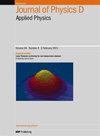Insights into the magnetic signature in VS2 nanosheets for spintronics applications: an experimental and ab initio approach
IF 3.2
3区 物理与天体物理
Q2 PHYSICS, APPLIED
引用次数: 0
Abstract
VS2 nanosheets were synthesized using a facile hydrothermal method with varying hydrothermal durations for detailed study of their magnetic properties for spintronics applications. The (001) peak near 15.45° in the x-ray diffraction pattern confirmed the formation of the hexagonal phase of VS2 consistent with the Raman spectrum and high-resolution transmission electron microscopy study. X-ray photoelectron spectroscopy confirmed the formation of VS2 with the +4 oxidation state of V. Morphology was determined by field emission scanning electron microscopy that showed the morphological transition from nanoflowers to nanosheets with increase in the hydrothermal duration from 16 h to 24 h. The VS2 nanosheets were subject to magnetic measurements using a superconducting quantum interference device. The isothermal magnetization versus magnetic field plot showed typical hysteresis behaviour at low fields with maximum saturation magnetization of 3.25 memu g−1 at 50 K which gradually decreased with increase in temperature. The coercivity , however, increased with increase in temperature, hinting at the possible short range of the existing ferromagnetic (FM) order. The field-cooled and zero-field-cooled curves showed a lack of FM clustering. Fitting of the magnetization versus temperature plot showed the formation of a mixed magnetic phase, that is both a paramagnetic (PM) phase (at high fields) and a FM phase (at low fields). The PM Curie temperature obtained from the fitting hinted at canted antiferromagnetic order. Magnetoresistance (MR) measurement in a current parallel to the field configuration revealed a negative MR of 10.4%. Further, density functional theory and Monte Carlo simulations based on the Metropolis algorithm were used to study the layer-dependent electronic band structure of VS2 as well as its Curie temperature for its applicability in spintronics devices.洞察用于自旋电子学应用的 VS2 纳米片中的磁特征:实验和 ab initio 方法
我们采用简便的水热法合成了 VS2 纳米片,并改变了水热持续时间,以详细研究它们在自旋电子学应用中的磁性能。X 射线衍射图谱中 15.45°附近的 (001) 峰证实了 VS2 六方相的形成,这与拉曼光谱和高分辨率透射电子显微镜研究结果一致。X 射线光电子能谱证实 VS2 的形成具有 +4 的 V 氧化态。通过场发射扫描电子显微镜测定了形态,结果表明随着水热时间从 16 小时增加到 24 小时,形态从纳米花过渡到纳米片。等温磁化与磁场的关系图显示了低磁场下的典型磁滞行为,50 K 时的最大饱和磁化率为 3.25 memu g-1,随着温度的升高,饱和磁化率逐渐降低。然而,矫顽力随着温度的升高而增加,这表明现有的铁磁(FM)阶可能是短程的。场冷却和零场冷却曲线显示缺乏铁磁簇。磁化率与温度的拟合曲线显示形成了混合磁相,即顺磁(PM)相(在高磁场下)和铁磁(FM)相(在低磁场下)。拟合得到的 PM 居里温度暗示了悬臂反铁磁秩序。在电流与磁场配置平行的情况下进行的磁阻(MR)测量显示,MR 为负 10.4%。此外,基于 Metropolis 算法的密度泛函理论和蒙特卡罗模拟被用来研究 VS2 与层有关的电子能带结构及其居里温度,以确定其在自旋电子器件中的适用性。
本文章由计算机程序翻译,如有差异,请以英文原文为准。
求助全文
约1分钟内获得全文
求助全文
来源期刊
CiteScore
6.80
自引率
8.80%
发文量
835
审稿时长
2.1 months
期刊介绍:
This journal is concerned with all aspects of applied physics research, from biophysics, magnetism, plasmas and semiconductors to the structure and properties of matter.

 求助内容:
求助内容: 应助结果提醒方式:
应助结果提醒方式:


